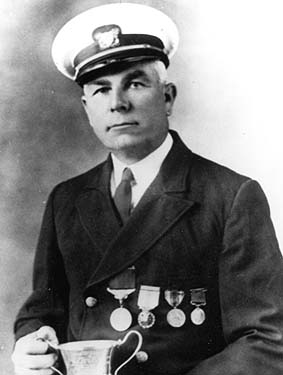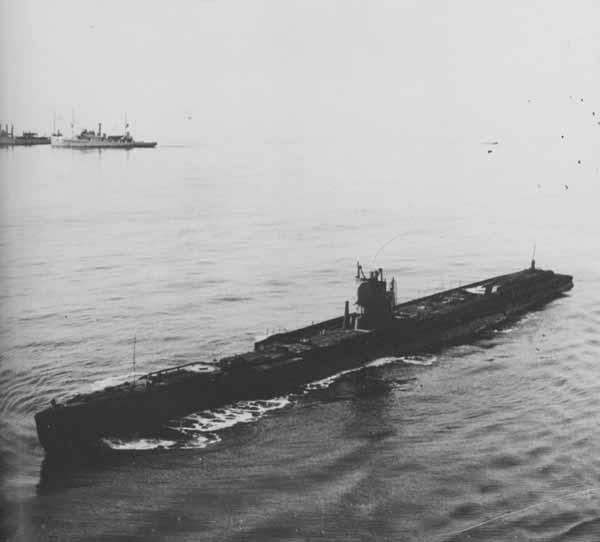Baptism of Fire: The Rescue of the SS Mirlo
One hundred years ago, on the afternoon of Aug. 16, 1918, British tanker SS Mirlo was steaming through wind-swept seas north of Cape Hatteras, North Carolina. At about 4:30 p.m., a torpedo from German U-boat U-117 ripped into her hull, shooting up a column of water. The hit was seen seven miles away by the lookout at the Chicamacomico Coast Guard Station in Rodanthe, North Carolina. Flames leaped into the sky as a cargo of fuel gushed out of the Mirlo's hull and caught fire.
 Despite any fears that station keeper John Allen Midgett might have had about entering the flames surrounding the tanker, he mustered his crew and initiated rescue operations within minutes of the explosion. A veteran keeper at Chicamacomico, Midgett (left) came from a long line of lifesavers. Members of Midgett’s extended family had been surfmen for over 40 years. John’s relative Rasmus Midgett had received the Gold Lifesaving Medal for a daring rescue in 1899, and all but one of John’s crew bore the Midgett name.
Despite any fears that station keeper John Allen Midgett might have had about entering the flames surrounding the tanker, he mustered his crew and initiated rescue operations within minutes of the explosion. A veteran keeper at Chicamacomico, Midgett (left) came from a long line of lifesavers. Members of Midgett’s extended family had been surfmen for over 40 years. John’s relative Rasmus Midgett had received the Gold Lifesaving Medal for a daring rescue in 1899, and all but one of John’s crew bore the Midgett name.
After donning their kapok life preservers, Midgett’s crew threw open the station doors and hitched their motor surfboat’s carriage to a dray horse. Midgett stood in the bow of the oar and motor-powered boat holding the reins as the horse pulled the boat across the beach to the surfline. Having frequently drilled his men in launching procedures, Midgett’s boat and crew reached the water less than a half-hour after Mirlo’s explosion. Launching into the breakers proved more dangerous. It took four attempts to breach the heavy surf before the boat cleared the waves.
By 5 p.m., Midgett began motoring out from the beach. On the way, he spotted the first of Mirlo’s three lifeboats and directed its occupants to row toward land and wait for him to take them ashore. Next, Midgett steered his boat close to the burning wreckage. Through the flames, he spotted a capsized lifeboat with six victims clinging to it. Up to that time, no Coast Guardsman had been trained to rescue survivors from burning water, so Midgett improvised. His men wrapped cloth around their faces and one surfman used an oar to strike water ahead of the boat to open the curtain of fire. Midgett forced his way through floating debris while flames singed the boat’s white hull. He later learned that when the overturned lifeboat hit the water, it had 15 crew members inside; however, the fire became so intense the men had to choose between drowning and burning to death. Eventually, nine of them drifted away succumbing to one fate or the other.
After hauling the six survivors on board, Midgett escaped the fiery cauldron and motored downwind to locate the third lifeboat. It was drifting helplessly before the wind overcrowded with nearly 20 survivors so no one could man the oars. Midgett took the boat in tow and headed to shore where the first lifeboat was waiting. Even though the seas were heavy and night had fallen, Midgett and his men skillfully ferried the survivors 10 at a time to the beach through the large breakers. There, other lifesaving crew members waited to care for the tanker’s survivors.
Midgett and his five-man boat crew saved 42 British merchant mariners without the loss of a single surfman. Later, Mirlo’s captain, William Williams, wrote Midgett, “Had it not been for your promptness in putting out to sea, and going to the fire as you did, the loss of life would have been much greater.”
For their heroism, each Chicamacomico man was awarded the Coast Guard’s Gold Lifesaving Medal and the equivalent gold medal from the British government. In addition, the American Cross of Honor Society awarded the surfmen the prestigious Grand Cross Medal for bravery. Coast Guard Commandant Ellsworth Bertholf recommended the men for the prestigious Navy Cross Medal, however, the Navy never acted on his recommendation. John Midgett also received a ceremonial silver cup presented to him by the British Board of Trade.
In spite of Mirlo’s memorable last hours on the water’s surface, the site of the wreck on the seafloor has never been found. The day after the rescue, the surviving crew members were transported to Norfolk, Virginia, for recuperation before they returned to the United Kingdom. After attacking Mirlo, German submarine U-117 returned to her homeport of Kiel, where she sat out the rest of World War I. After Germany’s surrender, the U-boat returned to the U.S. as a war prize and toured American seaports as part of a Victory Bond drive. The Navy sunk U-117 as a target in 1921. After serving over 40 years in the Coast Guard, John Midgett was severely injured in a car accident in 1937. He lingered for several weeks and died in Norfolk the next year.

U-117 after the war (U.S. Navy)
The German U-boat attack on Mirlo marked a turning point in marine search and rescue. Before World War I, coal had provided the fuel for large machines such as ships, power plants and railroad locomotives. Liquid fuel and chemical spills were largely unknown until the early 20th century; hence, Coast Guardsmen were not trained to rescue victims from oil spills and water-borne fires. The Mirlo rescue brought new meaning to the old Lifesaving Service motto, “You have to go out, but you don’t have to come back.”
William Thiesen, Ph.D. is the Coast Guard Atlantic Area historian.
This article appears courtesy of Coast Guard Compass and is reproduced here in abbreviated form. The original may be found here.
The opinions expressed herein are the author's and not necessarily those of The Maritime Executive.
